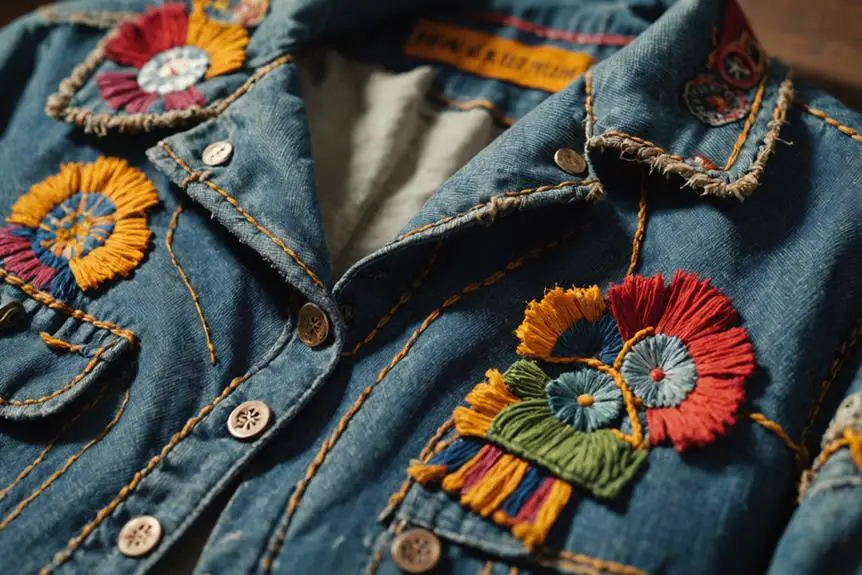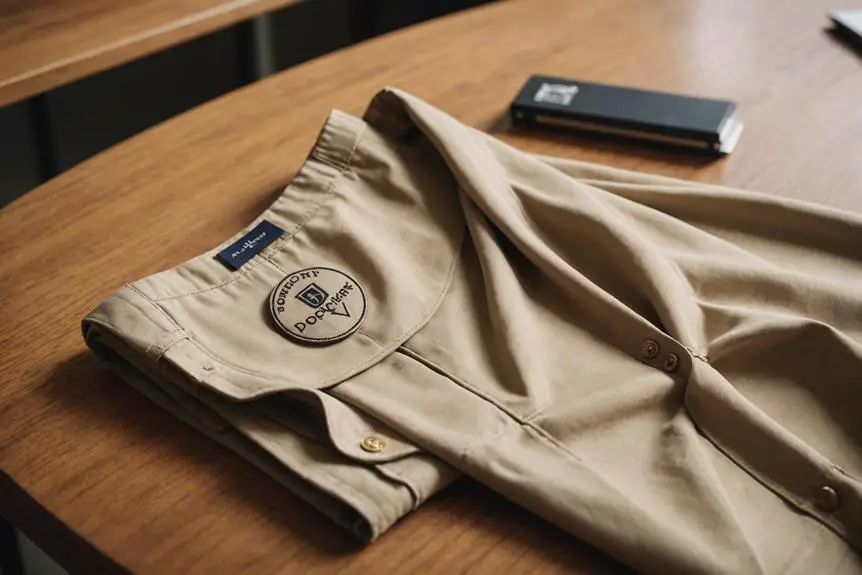Is it really possible to restore fraying cuffs on your jacket without sacrificing its overall look? Many believe that once the fabric starts to unravel, it's a lost cause, but that's not necessarily true. You can take a few simple steps to not only repair but also enhance the durability of your jacket's cuffs. Understanding the right techniques and materials can make all the difference, so let's explore what you need and how to approach this restoration effectively.
Assessing Jacket Condition
When you notice fraying cuffs on your jacket, the first step is to assess its overall condition. You wouldn't actually want to plunge into repairs without checking the rest of the jacket first. Look closely at the cuffs for signs of fraying, damage, or wear. If you see any questionable spots, it might be time to contemplate a little TLC for the whole jacket. Additionally, understanding the fabric type can help you select appropriate materials for the repair process, especially if it's a delicate knit or vintage piece upcycling reduces textile waste.
Next, take a step back and assess the fabric condition. Is it still in good shape, or are there other areas that need attention? It's like giving your jacket a mini check-up! Keep your eyes peeled for any other signs of deterioration, because those might need some love too.
While you're at it, snap a few photos. Seriously, it's super helpful to document the extent of the damage. You might think, "Why bother?" but trust me, it'll come in handy when you're planning your repair strategy. Plus, you'll have a visual record to look back on.
Don't forget to contemplate the jacket's age and material. This can actually influence what methods and materials you'll use for effective repair. If it's a vintage gem, you might want to handle it with extra care. So, take a moment to appreciate your jacket's story before you jump into fixing those cuffs. After all, it deserves a little love, doesn't it?
Required Tools and Materials
Before diving into the repair process, gather the necessary tools and materials to guarantee a smooth experience. You'll want to start with a commercial home sewing machine. These machines are accessible and user-friendly, making them perfect for your cuff repair adventure. Plus, they usually come with great features that'll make sewing a breeze! Additionally, consider the importance of maintaining the integrity of your jacket, as proper fit and care can elevate its overall appearance and longevity, much like tailoring a vintage wool coat.
Next, grab some Black Pelon Shape Flex (SF-101). This handy interfacing is a game-changer, reinforcing those damaged cuff areas like a champ. Don't forget seam tape, like the Hug Snug brand, to cover those pesky gaps and give your cuffs some extra strength. Having these materials on hand means you won't be scrambling mid-repair, right?
Now, for your cutting needs, snips are a must. These little tools will help you precisely cut the excess interfacing, giving you a clean and professional finish that'll impress even the toughest critics—like your friends! Remember, it's best to tackle one cuff at a time. This way, you can keep your reference points straight, ensuring everything aligns perfectly when you put it all back together.
Cuff Restoration Steps
Start the cuff restoration by carefully splitting open the damaged cuff to access the frayed areas. You'll want to get a good look at what needs fixing. Before diving in, it's wise to assess the jacket fit to guarantee the overall structure remains intact. Next, grab some Black Pelon Shape Flex (SF-101) interfacing. This stuff's a game-changer! Apply it to the inside of the cuff for added strength. Just make sure the sticky side is facing the right way; you don't want to accidentally glue down the wrong side.
Once that's in place, align the edges of the fabric. You want everything to fit just right! Use seam tape, like the Hug Snug brand, to cover any gaps and reinforce those edges. Trust me, this little step can save you from future headaches.
Now, let's tidy up those corners. Mitering the corners of the cuff gives it a neat finish, which is what you're aiming for, right? Then, it's time to stitch the cuff back together. Keep the original cuff length in mind so you don't end up with a sleeve that's too short.
For that polished look, make sure all edges are neatly finished. No one wants their hard work to unravel! And here's a tip: check the other cuff for accuracy during reassembly. It's like having a cheat sheet! With these cuff restoration steps, your jacket will be looking sharp in no time. Who knew fixing fraying cuffs could be this fun?
Repair Techniques
Repair techniques for fraying cuffs can make a significant difference in the longevity and appearance of your jacket. First off, you'll want to split open the cuff to access those pesky damaged areas. This gives you the chance to really tackle the problem head-on. Ready? Grab some black Pelon Shape Flex (SF-101) interfacing. Apply it to reinforce those frayed sections, making certain the sticky side faces the fabric for a solid hold. This step is essential for guaranteeing a strong foundation, similar to how reinforcing seams is vital in tailoring vintage pieces.
Now, if you've got gaps, don't fret! Using seam tape like Hug Snug can cover them up nicely. Just remember to miter those corners for a clean, professional look. It's all about that attention to detail! For those of you who like a little control, sew-on seam tape is your friend. You'll find it easier to manage than iron-on tape, and addressing one cuff at a time means you won't mix things up.
When you get to sewing, adjust your sewing machine settings according to your cuff fabric types. This guarantees you're working with the right tension and stitch length, making your life a lot easier! Finally, finish all edges neatly—that'll keep future fraying at bay. Just be careful to maintain the original cuff length during the whole process. Trust me, your jacket will thank you for it! Ready to jump in? Let's get those cuffs looking sharp again!
Finishing Touches and Tips
When it comes to putting the final touches on your jacket's cuffs, attention to detail is key. You've worked hard to fix those fraying edges, so let's make sure they look amazing! Start by ensuring all edges of the cuff are neatly finished using a sewing machine or serger. This prevents future fraying and keeps everything looking sharp.
Now, let's talk about maintaining the original cuff length. You want to preserve the jacket's overall style choices and fit, right? Reference the other cuff for accurate reassembly, ensuring both cuffs match perfectly in appearance and functionality.
Here's a quick table to help you visualize some handy tips:
| Task | Importance | Tips |
|---|---|---|
| Neat Edges | Prevents fraying | Use a sewing machine |
| Match Length | Maintain aesthetics | Measure against original |
| Symmetrical Finish | Professional look | Align carefully |
| Good Press | Polished appearance | Iron after sewing |
| Regular Maintenance | Long-term care | Follow fabric options |
After you've got everything sewn up, finish with a good press using an iron. This sets the seams and gives your cuffs that polished look, making them ready for wear. Remember, proper maintenance tips will keep your jacket looking fresh for years to come. So, what are you waiting for? Get to it, and show off those stylish cuffs!
Frequently Asked Questions
How to Mend a Frayed Jacket Cuff?
To mend a frayed jacket cuff, explore cuff repair techniques using the right fabric selection tips. Gather your sewing tools guide, and get ready to reinforce, sew, and finish edges for a polished look.
How to Replace Cuffs on a Jacket?
Replacing cuffs on your jacket is like transforming a pumpkin into a carriage! Choose stylish cuff fabric options, master sewing techniques, and add unique cuff embellishments to create a fresh, personalized look that dazzles everyone.
How to Fix Stretched Jacket Cuffs?
To fix stretched jacket cuffs, you'll need cuff repair techniques suited for various fabric types. Gather essential sewing tools, assess the damage, and reinforce seams to restore structure and prevent further stretching effectively.
How Do You Finish Sleeve Cuffs?
Imagine a painter perfecting their masterpiece; you can achieve the same with cuff finishing techniques. Choose vibrant fabrics, select your sewing machine options wisely, and let each stitch reflect your dedication to detail and style.




